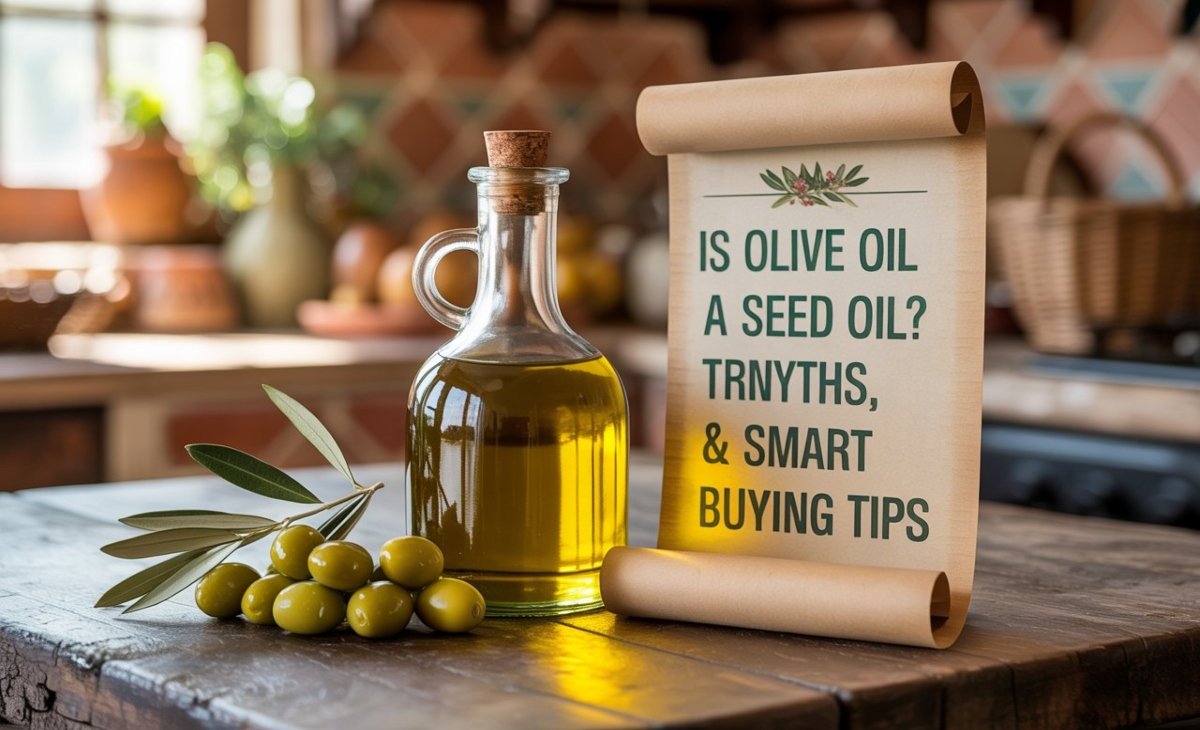If you’ve ever wondered is olive oil a seed oil, you’re not alone. Stroll through a grocery aisle and you’ll see rows of olive oil bottles promising Mediterranean magic and heart-healthy perks. Yet with all the talk about “seed oils,” many shoppers question where olive oil fits in. The short answer: olive oil comes from fruit, not seeds—but there’s more to the story.
This guide explains what makes an oil a seed oil, why olive oil is different, and how to choose authentic bottles that deliver the health benefits you expect.
What Are Seed Oils?
Seed oils are extracted from the seeds of plants such as canola, sunflower, soybean, cottonseed, grape seed, and sesame. These oils are typically produced through high-heat methods and chemical solvents before being refined, bleached, and deodorized.
Because of these processes, seed oils often contain high levels of omega-6 fatty acids. While omega-6s are essential in small amounts, excessive intake—especially without balancing omega-3s—may promote inflammation and oxidative stress. Overheating seed oils can also generate harmful compounds like aldehydes and free radicals, which are linked to cellular damage and chronic health concerns.
Is Olive Oil a Seed Oil?
Here’s the key distinction: olive oil is not a seed oil. It’s a fruit oil, made by pressing the flesh of olives rather than extracting oil from seeds. Extra virgin olive oil (EVOO) is produced by mechanically pressing ripe olives without chemical solvents or high heat, preserving antioxidants and polyphenols that benefit heart health.
However, the label doesn’t always tell the full truth. Some manufacturers dilute authentic olive oil with cheaper seed oils—like soybean, sunflower, or canola—to cut costs. This means a bottle that claims to be 100% olive oil might contain hidden seed oils if it’s from an unreliable source.
Why It Matters: Health and Authenticity
Knowing whether your olive oil is pure isn’t just about flavor—it’s about health. Genuine extra virgin olive oil contains powerful antioxidants and monounsaturated fats that support heart health and reduce inflammation. But when olive oil is blended with refined seed oils, you lose many of those benefits and may unknowingly increase your omega-6 intake.
Adulteration can also pose allergy risks. Some counterfeit olive oils have been found to contain hazelnut oil, which can trigger severe reactions in sensitive individuals.
How Olive Oil Is Made
True EVOO comes from a straightforward, natural process:
- Harvesting: Olives are picked at peak ripeness.
- Pressing: The fruit is crushed into a paste, and the oil is separated mechanically—no chemicals required.
- Bottling: The oil is filtered and bottled to preserve freshness and flavor.
This gentle extraction keeps the natural antioxidants intact, giving extra virgin olive oil its signature peppery taste and healthful qualities.
Common Problems: Olive Oil Fraud
Food fraud is a growing issue. Investigations have found that a significant portion of “extra virgin” olive oil on store shelves is not pure. In some cases, organized groups import cheaper oils, bottle them in Italy, and label them as premium Italian EVOO.
Even bottles with certifications like “PDO” or “PGI” have occasionally been implicated in fraud. That’s why shoppers can’t rely on labels alone to guarantee authenticity.
Tips to Choose Seed-Oil-Free Olive Oil
Finding authentic olive oil takes a bit of effort, but these steps can help:
- Read the Label Carefully: A true extra virgin olive oil should list only “olive oil” as the ingredient. Avoid vague terms like “light” or “blend.”
- Check the Harvest Date: Look for a harvest or press date within the past 12–18 months for the freshest oil.
- Consider the Source: Buy from reputable brands, specialty markets, or directly from producers with transparent sourcing. California extra virgin olive oils certified by the California Olive Oil Council (COOC) are excellent options.
- Smell and Taste: Authentic EVOO should smell grassy or fruity and have a slight peppery finish. Flat or greasy aromas may signal poor quality or adulteration.
- Be Wary of Bargains: Quality olive oil is expensive to produce. A price that seems too good to be true probably is.
Practical Advice for Home Use
- Use Fresh Oil Quickly: Once opened, try to use a bottle within three to four months for optimal flavor.
- Choose Dark Bottles: Dark glass protects the oil from light, slowing oxidation.
- Experiment with Flavors: Drizzle authentic EVOO over salads, bread, or roasted vegetables to enjoy its fruity, peppery notes.
The Final Word
So, is olive oil a seed oil? No—olive oil is a fruit oil, naturally pressed from olives. But the bigger issue is ensuring the oil you buy is genuine. With food fraud on the rise, knowing how to spot fake or adulterated bottles is essential for both flavor and health.
By learning to read labels, checking harvest dates, and buying from trusted sources, you can enjoy the full benefits of real extra virgin olive oil—without the hidden seed oils you’re trying to avoid.
Frequently Asked Questions
1. Is extra virgin olive oil healthier than regular olive oil?
Yes. Extra virgin olive oil is cold-pressed and unrefined, retaining antioxidants and a richer flavor compared to refined or “pure” olive oil.
2. Can olive oil go bad?
Absolutely. Olive oil has a shelf life of about 18–24 months. Exposure to heat, light, and air speeds oxidation, so store it in a cool, dark place.
3. What’s the best way to cook with olive oil?
Extra virgin olive oil works well for sautéing, roasting, and finishing dishes. For high-heat frying, you might prefer a more neutral oil with a higher smoke point, like avocado oil.





